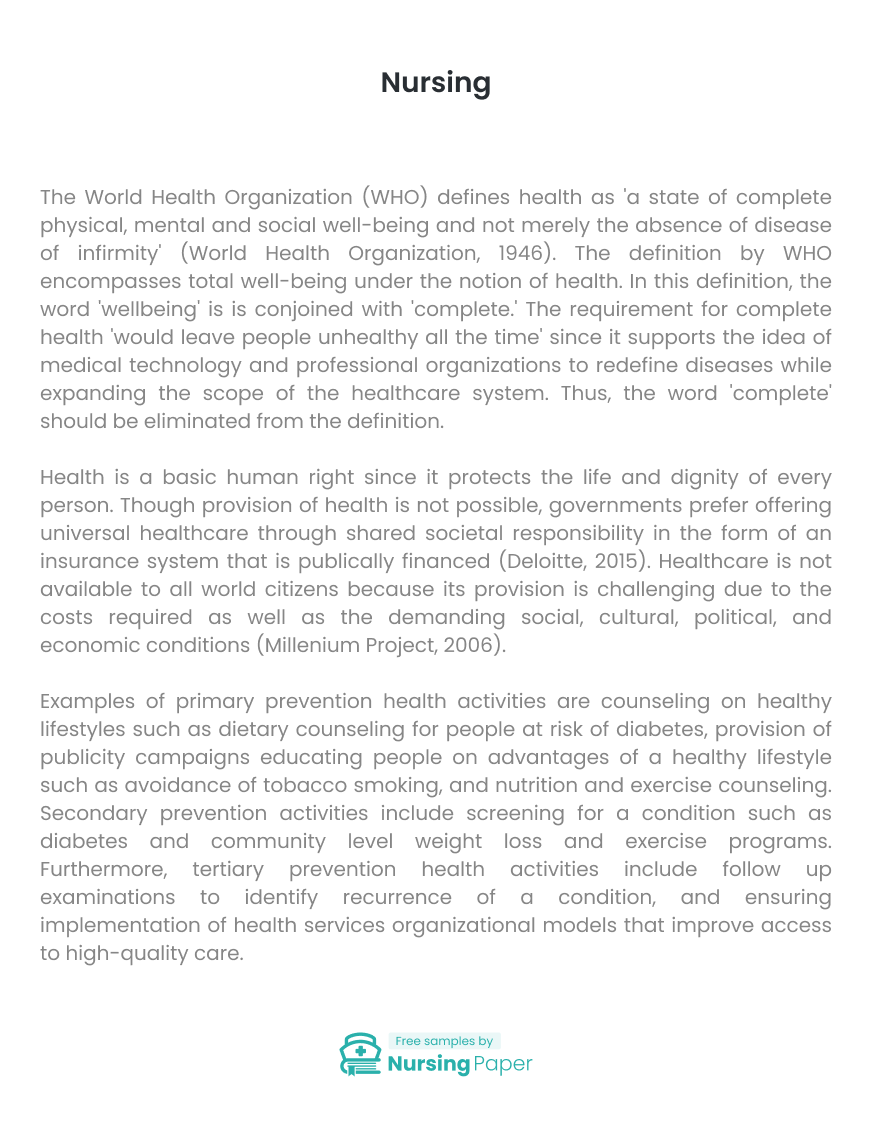
Nursing
Introduction
The World Health Organization (WHO) defines health as ‘a state of complete physical, mental and social well-being and not merely the absence of disease of infirmity’ (World Health Organization, 1946). The definition by WHO encompasses total well-being under the notion of health. In this definition, the word ‘wellbeing’ is is conjoined with ‘complete.’ The requirement for complete health ‘would leave people unhealthy all the time’ since it supports the idea of medical technology and professional organizations to redefine diseases while expanding the scope of the healthcare system. Thus, the word ‘complete’ should be eliminated from the definition.
Health is a basic human right since it protects the life and dignity of every person. Though provision of health is not possible, governments prefer offering universal healthcare through shared societal responsibility in the form of an insurance system that is publically financed (Deloitte, 2015). Healthcare is not available to all world citizens because its provision is challenging due to the costs required as well as the demanding social, cultural, political, and economic conditions (Millenium Project, 2006).


Examples of primary prevention health activities are counseling on healthy lifestyles such as dietary counseling for people at risk of diabetes, provision of publicity campaigns educating people on advantages of a healthy lifestyle such as avoidance of tobacco smoking, and nutrition and exercise counseling. Secondary prevention activities include screening for a condition such as diabetes and community level weight loss and exercise programs. Furthermore, tertiary prevention health activities include follow up examinations to identify recurrence of a condition, and ensuring implementation of health services organizational models that improve access to high-quality care.
1. Deloitte. (2015). Retrieved February 1, 2017, from 2015 Global health care outlook: Common goals, competing priorities: https://www2.deloitte.com/content/dam/Deloitte/global/Documents/Life-Sciences-Health-Care/gx-lshc-2015-health-care-outlook-global.pdf
2. Millenium Project. (2006). Millennium Villages: A New Approach to fighting poverty: The situation. Retrieved 2017, from Millenium Project: http://unmillenniumproject.org/mv/index.htm
3. World Health Organization. (1946, June 19-22). WHO definition of Health. Retrieved February 1, 2017, from WHO definitions: http://www.who.int/about/definition/en/print.html



The download will start shortly.

The download will start shortly.
 Subject:
Health and Social Care
Subject:
Health and Social Care  Number of pages: 7
Number of pages: 7  Subject:
Nursing
Subject:
Nursing  Number of pages: 5
Number of pages: 5  Subject:
Health and Social Care
Subject:
Health and Social Care  Number of pages: 3
Number of pages: 3  Subject:
Medicine
Subject:
Medicine  Number of pages: 4
Number of pages: 4  Subject:
Medicine
Subject:
Medicine  Number of pages: 4
Number of pages: 4  Subject:
Medicine
Subject:
Medicine  Number of pages: 4
Number of pages: 4  Subject:
Nursing
Subject:
Nursing  Number of pages: 7
Number of pages: 7  Subject:
Nursing
Subject:
Nursing  Number of pages: 3
Number of pages: 3  Subject:
Nursing
Subject:
Nursing  Number of pages: 10
Number of pages: 10  Subject:
Health and Social Care
Subject:
Health and Social Care  Number of pages: 2
Number of pages: 2  Subject:
Nursing
Subject:
Nursing  Number of pages: 6
Number of pages: 6  Subject:
Nursing
Subject:
Nursing  Number of pages: 6
Number of pages: 6  Subject:
Health and Social Care
Subject:
Health and Social Care  Number of pages: 4
Number of pages: 4  Subject:
Nursing
Subject:
Nursing  Number of pages: 7
Number of pages: 7  Subject:
Health and Social Care
Subject:
Health and Social Care  Number of pages: 2
Number of pages: 2 
